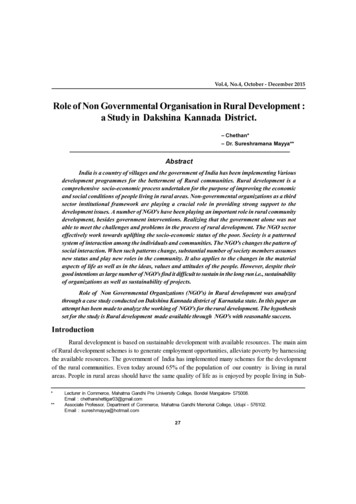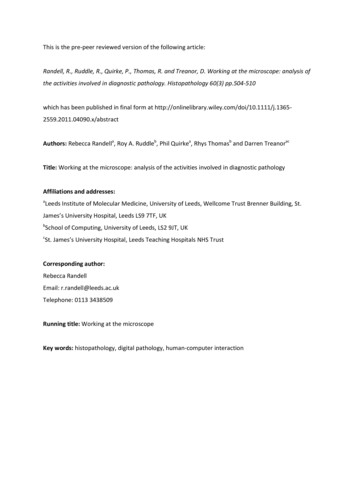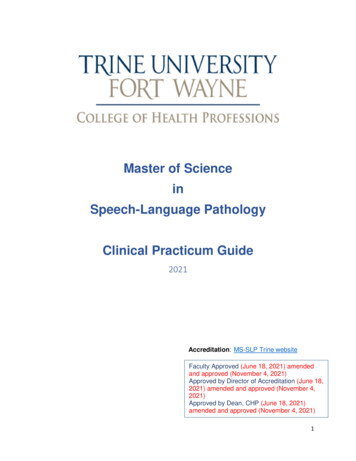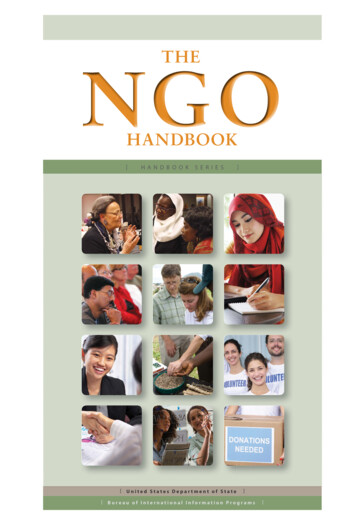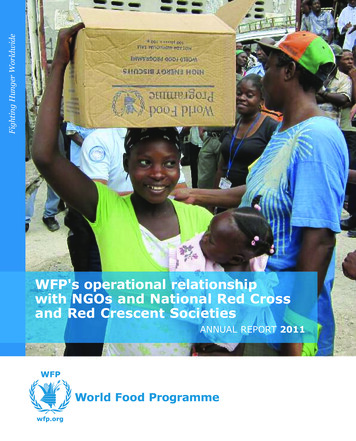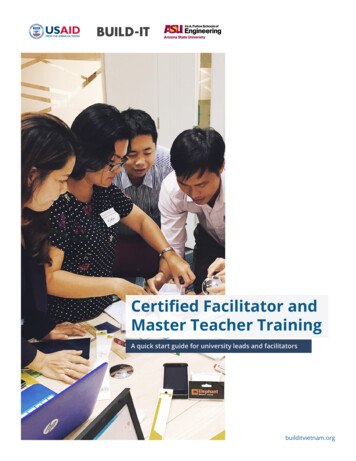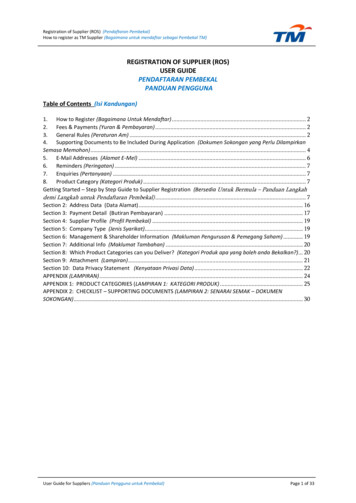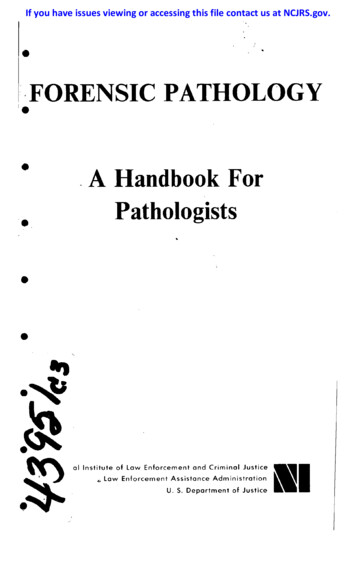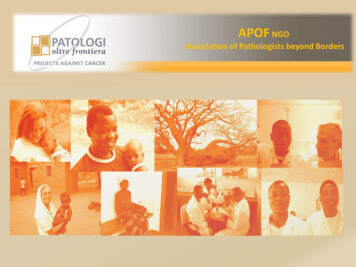
Transcription
APOF NGOAssociation of Pathologists beyond Borders
3rd WAKA HPV AFRICA SYMPOSIUMKinshasa, DR Congo2-4 December 2015An NGO devoted to surgical pathology:Challenges faced and yet to be addressedPaolo Giovenali
Mission Implementation of projects aimed at developing pathologyand cancer diagnostics in developing Countries Introducing cytological screening activities , in particular Pap smearsand needle aspiration cytology for cancer prevention . Sending volunteer pathologists , biologists or biomedical laboratorytechnicians Organization of residential stages in Europe for doctors ortechnicians Building pathology laboratories Training and the education of the local medical and technical staff,
Our main projects Establishment of Pathology Department in Bugando Medical Centre, Mwanza - Tanzania(2000- 2007) Establishment of Pathology Department in Mtendere Mission Hospital, Chirundu - Zambia(2007-2011) Support of the Pathology Department at Bethlehem - West Bank (2006-2010) Establishment of Pathology Department in CDS hospital, Fianarantsoa - Madagascar (2008) Improving diagnostic capabilities in Lacor Hospital (Gulu district). Uganda (2008- 2014) Functional strengthening of Pathology Department in Nsamby St. Francis Hospital, Kampala.Uganda (2010-2014) Establishment of Pathology Department in the Republic of Djibouti. (2012-2015) Training of health personnel in Southern and Lusaka provinces under the plan for preventionand treatment of cervical cancer. Zambia (2013-2014) Screening program for cervical and breast cancer in Imo State. Nigeria (2012-2015) Training of technicians in cytology and histopathological diagnosis by tele-pathology in theeastern provinces of North Kivu, Mungbere, Democratic Republic of Congo (2012-2015) Women Profile for Africa: screening program for cervical cancer at Kinshasa, DemocraticRepublic of Congo (2015-2015)
Our main partners and donnors AISPO NGO – Associazione Italiana per la Solidarietà fra i Popoli - ItalyASSIATEL - Italian Association of Lab TechniciansCEI - Italian Episcopal ConferenceCESVI NGO – Cooperazione e Sviluppo - ItalyChiesa Evangelica Valdese - Methodist and Waldesian ChurchesESP – European Society of PathologyItalian CooperationFondazione Umberto Veronesi - ItalyProvince of Venice - ItalySIAPEC - Italian Society of Pathology and CytologyUNDP (United Nations Development Programs)University of Florence - Italy
Pathology Services in Developing CountriesWHY?
Projected deaths (000s) by cause in WHO RegionsInfectious disease , maternal and perinatal condition andnutritional deficienciesAFRICAMIDDLE EASTEUROPE
Projected deaths (000s) by cause in WHO RegionsMalignant neoplasmsAFRICAMIDDLE EASTEUROPE
Projected deaths (%) by cause in WHO RegionsMalignant neoplasmsAFRICAMIDDLE EASTEUROPE
Pathology Services in Developing CountriesWHERE?
which country?
Human development index
which hospital?
Definitions and Terms for Different Levels of Hospital Primary-level hospital: few specialties—mainly internal medicine,obstetrics and gynecology, pediatrics, and general surgery, or justgeneral practice; limited laboratory services available for generalbut not specialized pathological analysis Secondary-level hospital: highly differentiated by function with 5 to10 clinical specialties; size ranges from 200 to 800 beds; oftenreferred to as a provincial hospital Tertiary-level hospital: highly specialized staff and technicalequipment — for example, cardiology, intensive care unit, andspecialized imaging units; clinical services highly differentiated byfunction; could have teaching activities; size ranges from 300 to1,500 bedsFrom Mulligan, J., et Al. 2003. "Unit Costs of Health Care Inputs in Low and Middle Income Regions." Working Paper 9, DiseaseControl Priorities Project, Fogarty International Center, National Institutes of Health, Bethesda, MD.
Hospital’s minimum requirements General surgery Gynecology Outpatient clinic (Oncology)
Pathology Services in Developing CountriesHOW?
Needing to address three important challenges:
Society & EnvironmentOrganizationSR-strategy &activitiesInteractions,Partnership &DialogueSustainableoutcomeStakeholdersISO 26000 - 2010
INFRASTRUCTURE AND EQUIPMENT Building and/or renewing lab infrastructure Safety (fume hoods, AC, etc)Electricity supply (UPS)Water supplyEquipment compatible with local technologies Maintenance programSpare parts availability
PROVISION OF LABORATORY SERVICES Defining main process and related procedures Informatic system Lab proceduresDefining standard requirements Patient / specimen registrationReportingReport validation and deliveryTATDiagnostic check listsQuality controls
HUMAN RESOURCES Three different settings:1. Senior pathologist(s) present; lab not working orworking with serious lack of resources2. No senior pathologist present; only junior or ontraining pathologist(s) available3. No pathologist present; only lab technicians available
Setting 1(Senior pathologist(s) present) Program of technical assistance for : Training (on job): pathologist(s) and technicians Standardization procedures/protocols diagnostic check lists quality controls (telepathology) Supporting growth New techniques (FNA, Immunohistochemestry) Participation to national programs (i.e. screening)
Setting 2(only junior or on-training pathologist(s) present) Program of technical assistance for : Continuous on-site diagnostic activity and training on job:pathologist(s) and technicians Standardization Procedures/protocols diagnostic check lists quality controls (telepathology) Supporting growth Supporting the achievement of qualification andacademic knowledge: pathologist(s) and technicians New techniques (FNA, Immunohistochemestry) Participation to national programs (i.e. screening)
Setting 3(only lab technicians present) Program of technical assistance for : Training (on job) – technicians Standard histo- cytology lab Gross examination and sampling Telediagnosis (scanner via-satellite internet) Standardization procedures/protocols diagnostic check lists Supporting growth Supporting the achievement of qualification and academicknowledge: technicians Critical issues High cost of connection Difficulties of sustaining continuous assistance for telediagnosis
Telepathology
Organization of the network of pathology labsPathology Lab 1(only technical staff)Pathology Lab2APOF(only technical staff)COORDINATING CENTERPathology Lab 3(only technical staff)Pathology Lab 4(at least one pathologist)
An hypothesis for the organization of the network ofpathology labsPathology Lab 1(only technical staff)Pathology Lab 2Referral Pathology Lab 1(only technical staff)(at least onepathologist)APOFPathology Lab 3(only technical staff)Referral Pathology Lab 2(at least onepathologist)Pathology Lab 4(only technical staff)COORDINATING CENTER
expertpathologists fordifficult casesand specificdiseasesMonitoringthe activitiesof each singlepathologistEncouraging andmanaging thefuture joining ofnew PathologyLabsSecond opinionfor diagnosessent by TERContinuingEducationStatisticaldata
Some examples
Bugando Medical CentreMwanza - Tanzania
Secretary’s RoomReception
Fine Needle Aspiration Room
Laboratory
Pathologist’s Room
BMC – Histopathology Dept.Diagnostic activity 1999-20072 senior pathologists3 technicians1 lab. assistant2 secretaries1 on-training pathologist1 technicianHistologyCytologyTOTAL
المستشفى بيت جاال - السلطة الوطنية الفلسطينية Palestinian National Authority - Beit Jala Governmental Hospital
Laboratory
Laboratory
Fine Needle Aspiration Room
Pathologist’s Room
Quality Controls
Laboratory
Tele-pathology
(Always something new from Africa)Pliny the Elder, “Historia Naturalis”www.apof.eu
A cow in Japan is worth 9 dollars a day.This means that a Japanese cow would be amiddle class Kenyan. and could very wellhead a humanitarian NGO.Binyavanga Wainaina (1971)Kenyan author, journalist and winner of the Caine Prize
Human Development IndexThe Human Development Index (HDI) is a compositestatistic used to rank countries by level of "humandevelopment" and separate "very high humandevelopment”, "high human development", "mediumhuman development", and "low human development"countries. The statistic is composed from data on life expectancy, education and per-capita GNI (as an indicator of standard of living orincome) collected at the national level using the formulagiven in the Methodology section below. There are also HDIfor states, cities, villages, etc. by local organizations orcompanies.
Calculating the HDIIndicatorMinimumMaximumLife expectancy 25 years 85 yearsAdult literacy0%100%Gross enrolment0%100%GDP per capita 100 (PPP* US ) 40,000 (PPP* US )*PPP: purchasing power parity
Calculating the HDI*Life expectancyindex85 years1Education indexLiteracy Enrolment(2/3)(1/3)100%Income index100%78.1140,000590.490 0%0%0.783(*Zambia, yr. 2013)10.5260000.4910.7862.425 yearsHDI0 1000.29000.29 0.52
Infrastructure and equipment challenges Lack of basic equipment Lack of consumables Lack of or erratic supply of pipe borne water Lack of or erratic supply of electricity
Challenges related to the provision oflaboratory services Non-availability of laboratory testing Client/patient dissatisfaction Turnaround time not usually defined Absence of good quality assurance Sample collection and transportation Cost of laboratory testing Delivery of result Patients’ attitude to testing Physicians’ attitude and behavior
Human resource challenges Limited number of skilled personnel Lack or inadequate training program Lack or inadequate training facilities Trainees who go abroad do not return Trainees who return lack facilities to apply what theylearnt Poor pay no job satisfaction
Safety (fume hoods, AC, etc) . BMC -Histopathology Dept. Diagnostic activity 1999-2007 1 on-training pathologist 1 technician. Palestinian National Authority - Beit Jala Governmental Hospital لااج تيبىفشتسملا- ةينيطسلفلا ةينطولا ةطلسلا .
